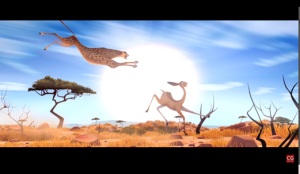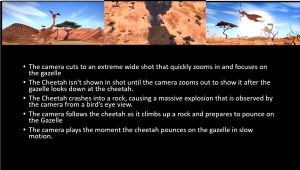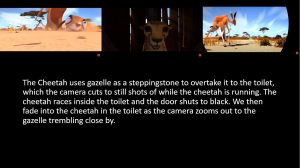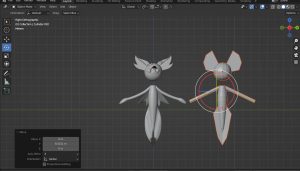Watching the animated short CG film Safari Swift, I noticed that the short parodies National Geo Graphic in the intro logo animation, that indicated the kind of genre that this short wants to convey, that it is a parody of nature documentaries.

The scene then cuts to the Savannah on a warm morning, with the lighting appropriately set up to match, as a David Attenborough narrates as the camera scrolls up from the ground to the wider landscape of the savannah. This is the establishing shot that shows us where the short takes place.
The scene then fades to black and then fades in to another extreme long shot of the Savanah, which for a few moments is completely silent until the gradually fading in sound of race cars fills the atmosphere. This quickly reveals another thing that Savanah swift, that it parodies race car programmes such as Formula 1, as we see a gazelle dash past the camera, which the camera then cuts to as it is running, the sound of a race car attached to it. We also hear African drums accompanying the chase scene, and in addition to the warm lighting, it further adds to the comical nature of the short.
The lighting of the short initially takes on a warm orange tone to trick the viewer into thinking they are watching a nature documentary, but once the first shot of the gazelle is shown, the lighting immediately changes to a bright daytime sunlight, to showcase the comedic side of the short.
Following this, the Gazelle is being chased by a Cheetah, who is designed to be much more sleek and focused than the arkward Gazelle running away from it, terrified. Throughout this short, the camera angles treat the animals like they are racing cars, even cutting to the running cheetah’s hindlegs to indicate a race car blowing exhaust. The cheetah’s sight starts to distort as it loses momentum on the deer, and glitching effects is applied as the deer fades form the cheetah’s view. The cheetah is forced to hit a rest stop, a fuel gauge ran by an otter who forces the fuel pipe into the cheetah’s mouth.
The otter and the fuel gauge are meant to represent pitstops seen in Formula One races, which are meant to serve as rest stops to change wheels on a race car or refuel it.
It is here where the camera goes inside the cheetah as it goes overboard from the energy that went into it, ending at its heart going into overdrive. We then leave the inside of the Cheetah’s body through its anus, and it speeds off, still imitating race car noises as it goes.
As the cheetah catches up with the gazelle, after a close up shot of the cheetah the camera switches to an extreme long shot that zooms in on the gazelle, but the cheetah crashes into a rock, causing a massive explosion. How big this explosion is is established through a birds eye view shot. This type of shot also is seen in a lot of formula one races when big crashes are involved.

The cheetah manages to recover from the explosion and climbs on to a rock to get the final jump on the gazelle which is captured in a slowmo shot, heightening up the tension of the shot…

Only for the cheetah to use the Gazelle as a stool so that it can get to a nearby lavatory. This subversion of our expectations isn’t shown in full sometime after the cheetah does its business, only showing it bit by bit by the handle and the wooden door.
It then zooms out from the cheetah in the toilet to the gazelle far behind, in shock over having two front paw marks on its behind. It also seems that the gazelle is also desperate to go to the toilet as well. A pinhole fade out focuses on the gazelle before completely cutting to black.

The camera never goes over the 180 degree rule except for when the cheetah takes a pitstop at the refuelling tank the otter is manning, and while exiting the cheetah’s body after it stops for a refuel, because it is coming out of the tail end of the cheetah.
. And because the short juxtaposes racing car noises with a cheetah and the gazelle running, we are made to not take this seriously and find this funny, as it parodies racing car programmes as well as nature documentaries.
The comedic twist of the Cheetah actually racing the Gazelle to the toilet subverts the viewer’s expectations as they initially were under the impression that the cheetah would eat the gazelle, but after seeing the Gazelle trembling after the cheetah makes it to the toilet, it is clear that isn’t the case.
I found the short to be quite fascinating to analyse, as there are many different comparisons between racing and Nature documentary programmes to be found within it. It was also interesting to point out the different designs of the Gazelle and the Cheetah, how the Cheetah is designed to be more sleek and focused than the googly eyed, awkward looking Gazelle. I also quite funny and subversive in regards to the story beats, such as when it was revealed the Cheetah needed to go to the toilet and beat the Gazelle to it. looking into the lighting and camera aspects of the short was also quite insightful.











